I thought I would write a little bit about our track at the moment. This is the second year that we’ve run one over winter, and I’m trying to learn from the mistakes we made last time!
The idea behind keeping horses on a track system, or “Paddock Paradise”, is to try and create a more natural environment for them to live in. Based on research by farrier Jaime Jackson, these pastures aim to recreate a wild horse’s lifestyle as closely as possible and, in doing so, help to create a healthier and happier horse.
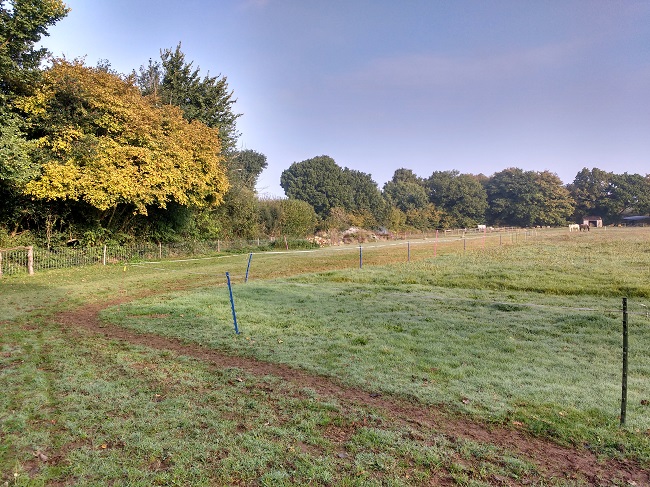
As we keep our horses on DIY, we are limited in what we can do with a track. Some paddock paradises’ are truly phenomenal – many people set up permanent fencing, put down different types of footing, incorporate logs, ditches and streams that must be crossed, and set up various feeding stations around the track to promote as much movement as possible and to fulfill the horses’ need to forage.
Compared to all that, our track is an incredibly simplified version. I decided to start using one for two reasons:
- To encourage more movement and create a more stimulating environment. After all, our herd might spend 20+ hours a day in their field without us to provide entertainment – I wanted to give them a set-up that was more interesting than your standard flat rectangle.
- To save money on our hay bill by prolonging the grazing.
That second one is a bit controversial because most track systems are kept either entirely grass-free or have very limited grazing. Adlib hay is the main food source as it mimics the horses’ natural diet – many of the paddocks our domestic horses are kept on are far too lush, and although they look nice, they can cause problems such as obesity, laminitis and other related health problems.
If I lived in a cheaper area of the country I might consider the grass-free approach, but the bottom line is that hay is very expensive here, as is the livery we pay to keep our herd – and if we’re going to be paying that much per horse, I would like to get our money’s worth and actually use the grazing we’re paying for!
Before I introduced a track system, we had been strip-grazing the same fields for three years previously without – touch wood! – any health issues. I think that as long as common sense is applied, there should not be any problem in allowing horses to eat grass.
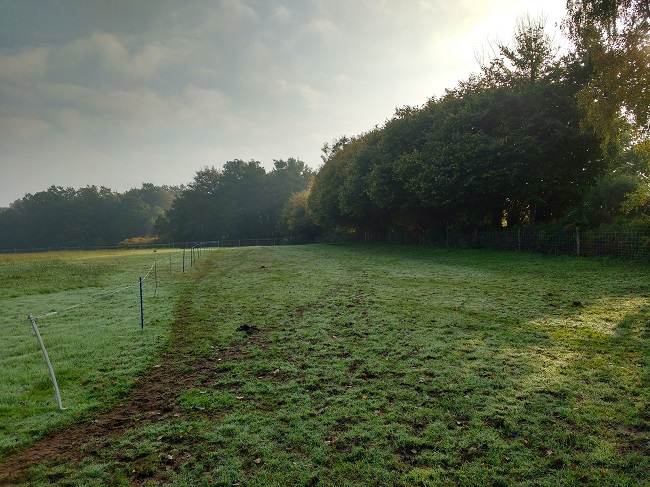
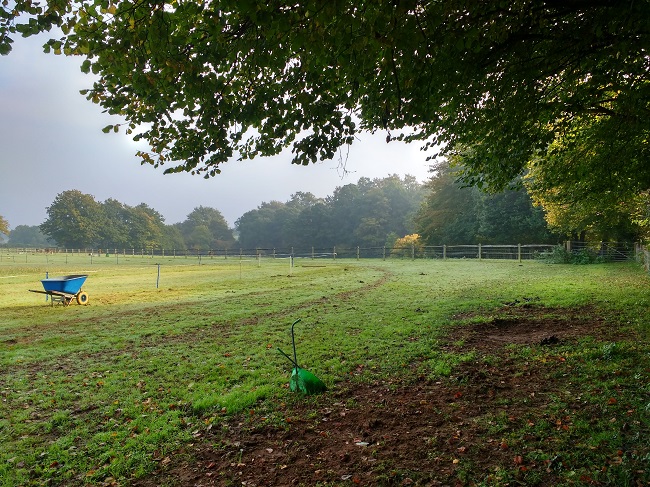
Mules are a slightly different matter because they can pretty much thrive on nothing. Marty, for example, is looking rather chubby at the moment despite the fact that he gets the same amount to eat as the horses do (he gets barely any hard feed, but has the same amount of access to hay and grass). When Xato arrives my plan is to put both mules together on a mini track of their own, with adlib straw rather than moving the fence for grass.
So anyway, this is how I run our track:
- When the herd move into the hay field for winter (the hay field is the largest field, which makes a track much easier to maintain), I start them off in a rectangular paddock at one side of the field and then strip-graze around the edge, forming a horseshoe-shaped track as I do.
- During the first month or so, when the grass is still growing, I will regularly move the fence in towards the centre of the track, graze down a section, and then move the fence back and allow the grazed section to rest and regrow. We don’t get a lot back, but we get some. Of course shorter grass contains more sugar so we have to be careful when we graze that section again.
- We only have a water trough on one side of the field, and when giving hay – which I do once the weather gets wetter and colder – I always put it on the opposite side of the track to encourage the herd to walk back and forth.
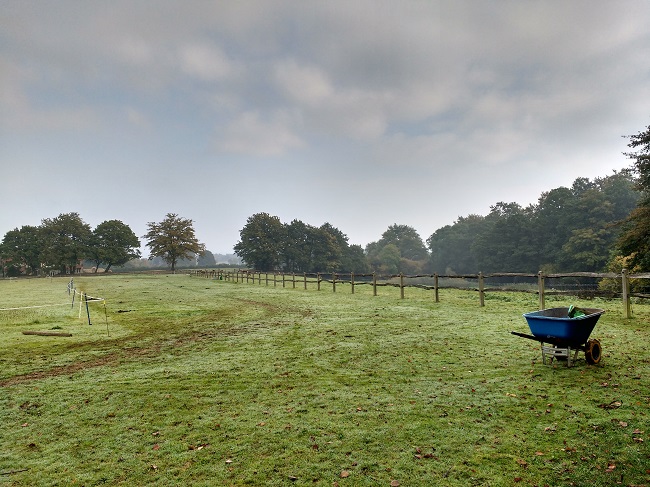
British weather is not very helpful when it comes to grass track systems, even when you’re on sandy soil like we are. Last year we got some horrible muddy areas in places such as the gateway and around the inner fencing, as the herd always take the shortest route to get anywhere. This was a problem because it’s the hay field and our landlord was understandably not impressed by us creating bald patches all over the place! So this year, I’ve made the track wider along the top, which was one of our biggest problem areas, and I’ve also regularly moved the fencing inwards and outwards in order to avoid constant wear-and-tear on any one area. This seems to be a good compromise so far, although we will have to wait until it gets really damp and miserable to see if it actually works.
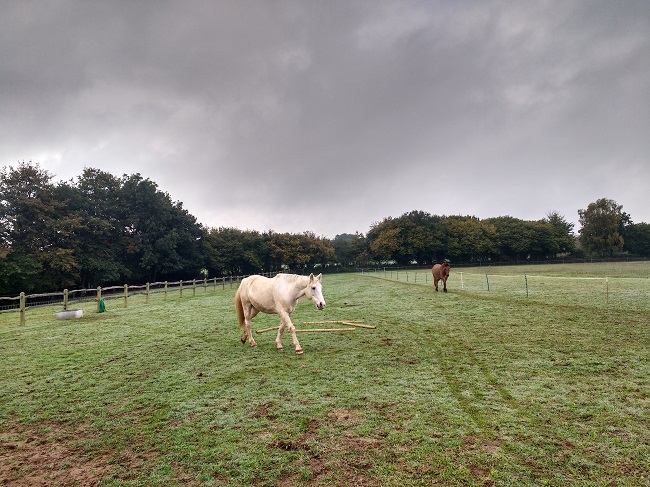
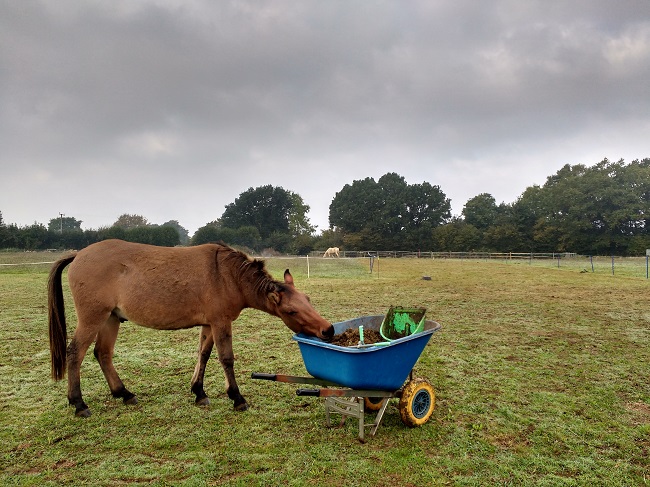
Last year I wasn’t sure what to do with the inner section of the track. A friend of mine, with whom Marty stayed for a little while after coming back from Anna’s, has a permanent track and then divides the middle into eight paddocks which she alternates between and lets her horses into overnight. I wasn’t sure if I would be able to do that easily without permanent fencing, so in the end we just moved one side of the track inwards until, dismayed by the muddy carnage we were creating, we gave up on the track idea entirely and returned to a standard field set-up.
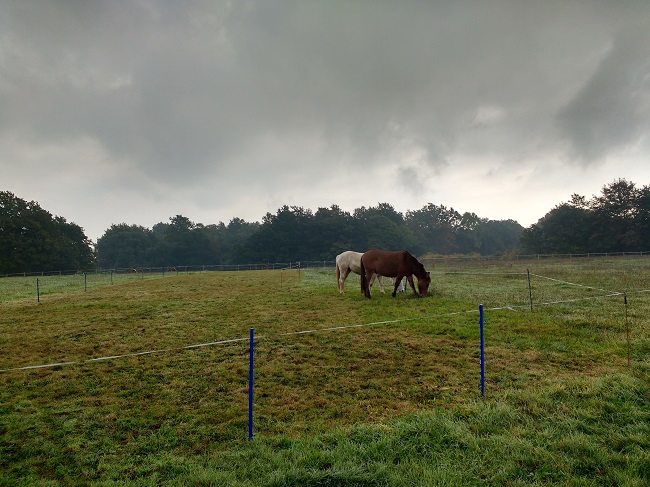
This year I would like to keep the track for as long as possible, mud permitting, and so my intention is to keep the basic shape but strip-graze inwards with one side of the track, then rest that and strip-graze inwards on the next side, and so on.
As a last thought: I have a close-ended track, rather than a full circuit, but that is only because a full circuit would require me to buy a fence charger to electrify the inner fence! At the moment, all our fencing is attached the the boundary fence which is mains run. I do feel that a close-ended track creates more movement than a full circuit, particularly if you set it up so that they have to be in one end if they want a certain thing, and at the moment all three of them seem to navigate it without issue. They certainly don’t seem annoyed or frustrated about having to walk from one end to the other. I think that is a very human concept – we are a notoriously lazy species!
This isn’t an exciting video, but I thought it showed the sort of distance they cover. I had moved the fence on one side of the closed-end track, then thrown a couple of small ground-nets into the other side. The boys obviously decided that the hay was more interesting and came round to eat it for a while, before leaving the nets for later and walking all the way back to graze again.
